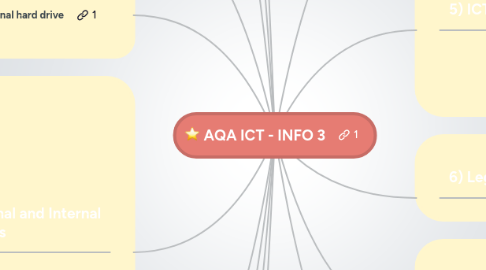AQA ICT - INFO 3
by Ian Brown


1. Microchips in pills One problem doctors have with their patients is that they do not know whether they have taken their medication. The only way that this can be done at present is to confine the patient to hospital so that staff can ensure they are taking their pills, but this is costly. As well as actually checking whether they take the pills, the medical staff have to check that the correct combination and number of pills are taken at the correct time. This can be a real problem with elderly or psychiatric patients who forget or do not understand the necessity of taking the pills. Help is now at hand through the use of ICT by the inclusion of a microchip being placed inside a pill. These sensors are digestible and only 1mm wide and their use allows doctors and surgeons to monitor patients outside the surgery or hospital. The system works by the pill activating a harmless electric charge when it is digested by the stomach. This charge is detected by a sensor placed on the patient’s stomach or back, which is also able to record the time and date. As well as doing this, the sensor is also able to measure physiological quantities such as heart rate, motion and breathing patterns. The information from the sensor is transmitted to the patient’s mobile phone and then transmitted using the Internet to the healthcare professional’s computer system. Doctors can then view this information on secure webpages and they can even have the information sent to their mobile phones. One doctor has said that the technology measures how a patient is getting better by giving important patient feedback. She said, ‘until now we could only get this level of feedback by keeping patients in hospital’. She went on to say, ‘it is hoped that the new system will free up beds and save the NHS money’.
2. http://timesofindia.indiatimes.com/india/DGCA-allows-uses-of-mobiles-in-aeroplane-mode-in-all-phases-of-flight/articleshow/34115524.cms
3. http://www.discovery.com/tv-shows/curiosity/topics/5-advances-molecular-nanotechnology.htm
3.1. Microchips capable of detecting cancer Scientists have developed a tiny microchip which can be used to detect one type of cancer, called prostate cancer, in the body. It works by detecting a certain protein molecule, which is typical in people likely to get this type of cancer. The device works by getting the proteins to stick to and bend a cantilever, which is just like a tiny diving board. The higher the concentration of the protein, the more the cantilever bends and the amount of bend is detected using a laser beam. It is also possible to put hundreds of these cantilevers on a single silicon chip, which will make it possible to detect many different types of cancer. The successful treatment of cancer is enhanced by its detection at an early stage, so in the future everyone might have one of these chips inside them. In the future it may also be possible to have drugs inside each person that would be released automatically into the patient if the early signs of cancer are detected.
4. cloud storage
5. LaCie external hard drive
6. 12) External and Internal Resources
6.1. Hire Vs Recruit (college case study)
6.2. Internal and External Resources
6.3. Offshoring Vs Outsorucing
6.3.1. Lesson answers
6.3.2. Reasons to outsource in the UK
6.3.3. class presentation
7. 2) Information and Systems
7.1. Formal and informal methods quiz
8. 4) ICT Strategy
9. 5) ICT Policies
9.1. security policy quiz
9.2. electronic data interchange
9.3. test
9.4. Back ups
10. 6) Legislation
11. 7) Developing ICT solutions
11.1. general quiz
11.2. Operating Systems
12. 8) Development Methods
13. 9) Techniques and Tools (system development)
14. 10) Introducing large systems
14.1. Support
14.1.1. class support tickets
14.1.2. types of maintenance feedback
14.2. Changeover methods
14.2.1. class notes on changeover D
14.2.2. class notes on changeover C
14.3. Large scale system testing
15. 11) Training and Support
15.1. Induction / internal / external
15.1.1. class test (C)
15.2. Computer based training
15.2.1. class test (D)
15.3. Group Training
15.3.1. Test responses and answers (C)
15.3.2. Test responses and answers (D)
15.4. Kahoot quiz
15.5. support
15.6. Exam Style Questions
15.6.1. TEST
15.6.2. Answers
15.6.3. Your answers
15.6.4. 20 Mark question
15.6.4.1. C block
16. Other
16.1. SWOT template
16.2. Unit Tests
16.2.1. unit 1
16.2.1.1. model test with ans
16.2.2. unit 2
16.2.2.1. model answers
16.2.2.2. answers and comments
16.2.3. unit 3
16.2.3.1. Answers and comments
16.2.3.2. model answers
16.2.4. unit 4
